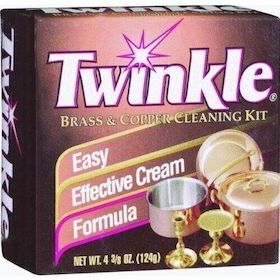
-----
Use sandpaper to remove scratches from copper hood?
Q. Can I use sandpaper to remove scratches from copper? I have made scratches while trying to clean a severely tarnished stove hood w/ my Dremel and a pumice stone. What is best to remove copper tarnish without scratching. I've tried Twinkle brass cleaner ⇦ on eBay or Amazon [affil link] , naval jelly ⇦ on eBay or Amazon [affil link] , Brasso ⇦ on eBay or Amazon [affil link] , and any other brand I could find. None easily remove the tarnish.
Aileen Raulinnurse - Chesapeake Beach, Maryland
2006
A. Hi Aileen,
I would not use sandpaper. Have you tried lemon and salt? Split a lemon in half, cover the surface with salt and scrub. If that won't work due to heavy oxidation, take lemon juice with a little water and use the lowest abrasive grade scotch brite, dip in solution and rub gently in the same direction until shiny. Rinse with damp cloth and buff dry with soft clean cloth. Good Luck!
process engineer - Malone, New York
2006
A. Sandpapers will do the task if you are patient, use the proper grit sizes and the described technique. Depending on the depth of the scratches (or tarnish) begin with the grade that easily removes them (for deep ones use grit 320 or 400, for tarnish maybe 600 is OK). Then go down and use successively finer grades of papers alternating direction of stroke (crossing) with every change until you get to No. 1500 or 2000. Every time you change to a finer paper keep sanding until there are no visible marks of the preceding one. Your surface will then be ready for polish. This is for simple shapes. Complicated geometries require a chemical approach such as electropolish, chemical polish or bright dip but it may not be suitable for a do-it-yourself job.
Guillermo MarrufoMonterrey, NL, Mexico
2006
A. Use this at your own risk. I used a 4-step finger nail buffer to remove scratches, BUT it can either make it too shiny.... or create more finer scratches.
Angie Philpott- Roanoke, VA USA
September 4, 2015
Q, A, or Comment on THIS thread -or- Start a NEW Thread
